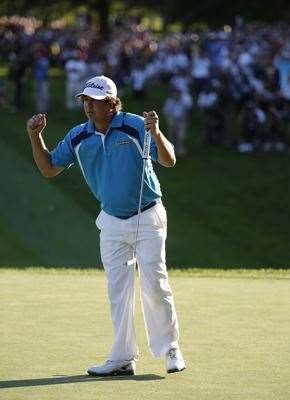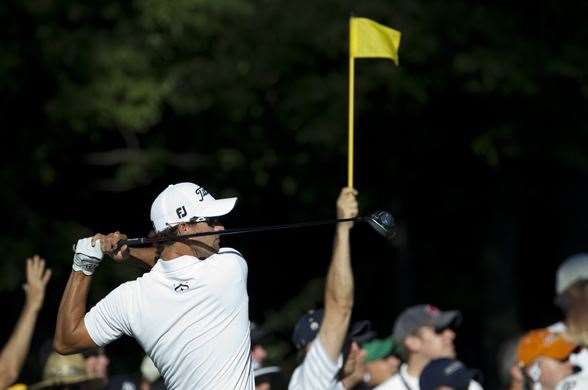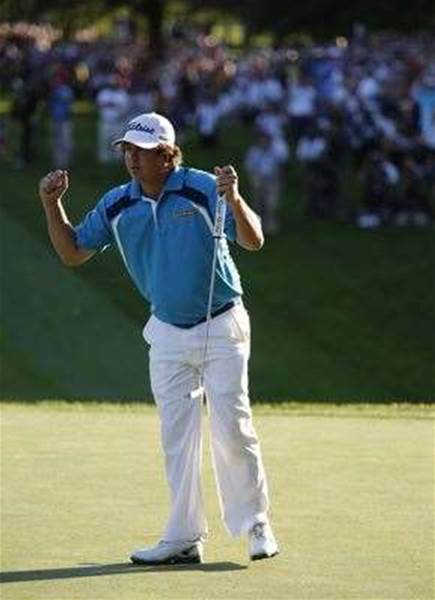American Jason Dufner put on a ball-striking clinic to claim the PGA Championship by two strokes from Jim Furyk, two years after throwing the same title away. Steve Keipert reports.
The art of “Dufnering” caught fire in the Twittersphere earlier this year when phlegmatic American professional Jason Dufner was photographed as he sat on a classroom floor, shoulders hunched, legs prone and zoned out, in a Texas school during a children’s charity visit. The humorous pose and unlikely craze spread to the rest of the PGA Tour, other pro sports and to anyone on Twitter who found it amusing – and all because it was a snapshot of Dufner in vintage form. Five months later, Dufnering took on a new meaning: the art of knocking iron shots stone dead during the final round of a major.
The solemn 36-year-old earned redemption for losing a United States PGA Championship he should have won two years ago by beating runner-up Jim Furyk at his own game and conquering Oak Hill Country Club to capture the 95th PGA by two strokes during an absorbing week in northern New York. Dufner won by carding four birdies in a closing 68, three of which stemmed from approach shots that all but went in the hole. Each blow was timed perfectly to break the spirits of playing partner and third-round leader Furyk, who couldn’t summon the requisite birdies to match the eventual champion.
 Jason Dufner pumps his fists after tapping in the victory. PHOTO: MARK NEWCOMBE/VISIONSINGOLF
Jason Dufner pumps his fists after tapping in the victory. PHOTO: MARK NEWCOMBE/VISIONSINGOLFDufner captured his first major and just his third PGA Tour title with a ten-under par total of 270 that included the 24th round of 63 in majors history. His course-record round on Friday helped him join a six-man club two days later as golfers who shot 63 en route to winning a major.
“It’s been a tough day. It was a long day. Tough golf course,” Dufner said in victory. “It probably hasn’t hit me yet. I can’t believe this is happening to me. To come back from a couple of years ago in this championship when I lost to Keegan [Bradley] in a play-off, to win feels really, really good.
“I just decided that I was going to be confident and really put my best foot forward and play aggressive and try to win this thing. I wasn’t going to just kind of play scared or soft … I’m happy to get the job done. It’s a big step in my career.”
Dufner’s solid tee-to-green game placed him among the favourites starting the week, particularly given his close call in 2011 and an ideal tune-up at the US Open in June, when his closing 67 moved him into a tie for fourth place for the second year running. This PGA stood to be decidedly US Open-like – held at a past US Open venue with fairways flanked by tall trees and thick rough – but few predicted the assault on par inflected by the so-called strongest field in golf. Twenty-one players finished in red figures on a layout where only ten golfers had previously bettered par for 72 holes of championship stroke play.
The bulk of the plundering occurred in the first two rounds as the menace that is Oak Hill’s East course lay dormant. Overnight night rain before the first round and steady rainfall in the early stages of day two spawned a softer, vulnerable layout where players more than countered the lack of fairway roll by firing at the flags with freedom. Subsequently, 35 in the field posted red numbers for the opening round and 27 remained under par at the halfway mark.
Furyk and Adam Scott posted five-under par 65s to share the first-day lead. On Friday Dufner shot his 63 and left short a 12-foot birdie chance on the 18th green for the first ever 62 in major-championship golf. Dufner nevertheless built a two-stroke lead at the midpoint by which time the course began waking from its slumber. Oak Hill went from soggy and serene to fickle and fierce as swirling winds dried out the surfaces. How different were Friday’s conditions to those on Saturday? Reigning US Open champion Justin Rose covered the outward half in 29 strokes to complete his second round and the next day toured those same nine holes in 42.
Curiously for a major tailored to his strengths, Furyk had never finished in the top-five at the PGA. Saturday’s firmer conditions played into Furyk’s hands as he shot a typically gritty 68 to lead by one stroke from Dufner heading into the final round, two clear of in-form Henrik Stenson, three ahead of another Swede in Jonas Blixt and four ahead of Steve Stricker and Scott. Holding top spot was both a blessing and a curse for Furyk, who held 54-holes leads four times in 2012 – most notably at the US Open – and came unstuck on each occasion. In the same vein, third-round leaders have not had much to celebrate of late at the majors. Since Darren Clarke converted his overnight margin into victory at the Open Championship two years ago, only Rory McIlroy at last year’s PGA has done likewise – now a one-in-nine strike rate.
 Champagne Dufner, steals another kiss with the trophy. PHOTO: MATTHEW HARRIS/TGPL
Champagne Dufner, steals another kiss with the trophy. PHOTO: MATTHEW HARRIS/TGPLThe scoring on Sunday was closer to the pre-cut flurry than Saturday’s grind. From back in the pack came a handful of 67s, 66s and a 65. In the final pairing Dufner birdied the 4th and 5th, the latter with the first of his pinpoint irons to a foot and on a hole he double-bogeyed a day earlier. Furyk warmed to the challenge by holing a long birdie putt at the 6th as both men ascended to ten-under, barely raising the pulse of either stoical protagonist. Dufner was at it again at the 8th, almost holing his second shot to raise the bar to 11-under. He turned the screws coming into the turn, fortifying pure ball-striking with three important par saves at the 6th, 7th and 9th that sandwiched his tap-in birdie at the 8th. At the 9th Furyk made the first bogey of the final duo to give Dufner a two-shot edge.
Dufner’s nonchalant approach belied some nerves on the greens. His long game was at its usual high standard and he rolled in several lengthy putts but closer to the hole he looked edgy and uncomfortable. Several extremely short putts barely found the cup – most notably at the 10th hole where he lipped in a par putt that could not have been much longer than a foot. He’s the kind of match play opponent to whom you would concede nothing longer than your scorecard.
Nothing, however, eroded his unflappable tee-to-green play. Dufner doesn’t amaze with awesome distance and he is inclined to throw in a loose drive from time to time, but overall he makes very few mistakes and at difficult venues that relentlessness is a supreme asset. During his Friday 63, Dufner holed his second shot at the par-4 2nd hole to kick-start his record round. In typical Dufner fashion, playing partner Stricker – hardly an extrovert himself – showed more emotion in celebrating the eagle than the man who authored the shot.
The happy coincidence of the two Swedes being paired in the penultimate group on Sunday was either going to be an omen or a burden for a nation still seeking its first men’s major champion. The Scandinavians always seemed a couple of shots too far back to put pressure on the last duo until a Stenson birdie at the 13th brought him within two strokes of the lead. That forward move was quickly erased by an unlucky bogey at 14 where his tee shot rolled into a sand-filled divot. Blixt, who’d recovered from some early mis-steps, birdied the same hole to put both golfers three behind with four holes remaining.
That proved too much ground to recover, a fact reinforced when Jason “Dufnered” again at 16. There was no idle slump of the shoulders here; instead Dufner once again spun an approach shot to a distance so close that no golfer could miss the putt. His final birdie matched Furyk’s, shut out the Swedes and maintained a two-shot cushion with two holes to play. Each player bogeyed the long 17th and even though both went from rough to rough on 18, their matching bogeys made it nine holes in a row where Dufner and Furyk made the same score, thus sealing Dufner a two-shot victory.
 Adam Scott never really got a good run going over the weekend. PHOTO: MATTHEW HARRIS/TGPL
Adam Scott never really got a good run going over the weekend. PHOTO: MATTHEW HARRIS/TGPLScott never fired on the weekend. A 72 on Saturday marred by a late double-bogey gave him little spark for Sunday. He missed a tiddler for par on the 1st green but immediately regained the shot with a birdie at the next and added another at the 4th. The seesawing continued, however, when he couldn’t save par from a buried lie in the sand two holes later. With the leaders making early birdies, even-par golf wasn’t making the impact he needed it to make. He would birdie the 9th and 12th holes but those red numbers only negated the birdies of the leaders rather that eroding his deficit. Scott’s lingering hopes were finally extinguished when he bogeyed the par-5 13th despite being close enough to the green to hit an iron for his second shot. Scott did provide a final highlight when he sank a greenside bunker shot for birdie at the par-3 15th, a hole where fans chose the final-round cup location in a PGA of America online contest.
* You can read Steve Keipert's full report in the September issue of Golf Australia, on sale on August 28
U.S PGA LEADERBOARD
1. Jason Dufner (US) 68-63-71-68—270 US$1,445,000
2. Jim Furyk (US) 65-68-68-71—272 865,000
3. Henrik Stenson (Swe) 68-66-69-70—273 545,000
4. Jonas Blixt (Swe) 68-70-66-70—274 385,000
T5. Scott Piercy (US) 67-71-72-65—275 304,000
T5. Adam Scott (Qld) 65-68-72-70—275 304,000
ALSO:
T8. Jason Day (Qld) 67-71-72-67—277 206,250
T12. Marc Leishman (Vic) 70-70-70-68—278 132,785
T40. Matt Jones (NSW) 72-71-73-68—284 28,000
T47. Marcus Fraser (Vic) 67-69-75-74—285 18,875
T70. John Senden (Qld) 72-70-73-76—291 14,950
MISSED CUT (143):
Brett Rumford (WA) 70-77—147; Geoff Ogilvy (Vic) 74-74—148
Related Articles

International Spotlight: Omanu Golf Club

Column: Hard miles in the Oban rain













